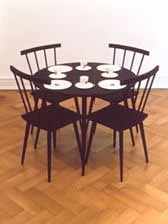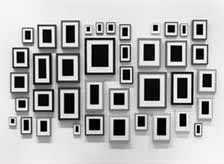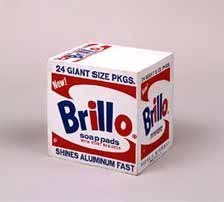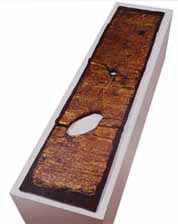Size counts. For many artists of the last half century, the issue of scale, from the miniscule to the massive, has been a critical concern. Increasingly during that period, our daily access to art took place through reproductions — a whole world of books, posters, postcards, and, not least, electronic media — that could be virtually any size in relation to their originals. As technological mediums gain greater importance in our lives, the experience of art is being radically transformed.
The works in this exhibition, though, promote direct experience. They approach and duplicate the real through distinct and contrasting strategies, evident in each section of the exhibition: mimesis versus imprints, representation versus presentation, presence versus absence, with both the human body and actual measurements providing fixed points of reference for determining scale.
DIMENSIONS OF THE REAL
Certain contemporary artists have addressed the issue of scale in exacting, literal ways, creating works that bear a one-to-one relation with the object they represent. With varying degrees of similitude, these works pose as slightly twisted duplicates of the real. Often painstakingly manufactured, they undermine absolute notions of true and false, bridging the distance between the authentic and the artificial. From Andy Warhol's Brillo Box (Soap Pads, 1964), to Jeff Koon's Baccarat Crystal set (1986), and from Lorna Simpson's Wigs (Portfolio, 1994), to Kiki Smith's Yolk (1999), these are works whose identities and allegiances shift from props to doubles, from stand-ins to facsimiles, and whose insistent theatricality often tricks the viewer's perception. Although these works obviously share an affinity with Marcel Duchamp's Readymades, they are not unmanipulated found objects, though they may look that way. Like Readymades, they raise questions about where life ends and art begins, but their handcrafted nature and use of artistic materials, following in the footsteps of Jasper Johns's bronze sculptures of commonplace objects, imply a desire to feed the paradox of appropriating something from the world while engaging the language of art. They are, ironically, fabricated readymades.
Robert Gober's incursions into the domestic have included several household objects rendered in actual size. Cat Litter (1989) may pass for the real thing, though nothing is done to disguise signs of the human hand. Adding a certain ambiguity to its already uncertain artistic status, Cat Litter sits on the floor nonchalantly, much as a bag of cat litter might in someone's home. Tom Friedman's Untitled (1995) shares this ability to disconcert the viewers while challenging definitions of art. Realistic in scale and intricately crafted, a tiny fly sits on the edge of a pedastal, occupying a space vastly larger than itself and radiating a perverse allure. Equally carefully placed in the perceptual gap between the illusory and the real is Steve Wolfe's Untitled (Cubism and Abstract Art, 1997), the works in this exhibition carry on a dialogue with art history's long tradition of the trompe l'oeil. They re-create and replace the world around us, visually visiting the limits of description.
IMPRESSIONS OF THE REAL
Simultaneously an autograph and a likeness, handprints are among the first images that humans are known to have made, pointing to our primordial impulse to leave a mark. A handprint of course involves the impression of a body onto a surface, leaving an image that maintains a fundamental physical relationship with the body, not only in appearance, but as an enduring trace of the action that caused it. Unlike replicas and doubles, the resulting identity and resemblance are not achieved through mimesis and illusion. Ghostlike traces, imprints of the body bear an indexical relationship to the departed figure, documenting an absence, a negative space, as much as a positive one. As images of immediacy from the realm of improvisation and chance, they signal forms of contact — sexual, anatomical, anthropological — as congealed materialized touch.
The history of modern art contains a sizeable number of images produced by direct impression (found in works by artists with such diverse concerns as man Ray, Pablo Picasso, Joan Miró, Alberto Giacometti, and Jackson Pollack, and including frottage, unmediated application of paint, and imprints on sensitive surfaces such as in photograms). There has been a resurgence of this kind of indexical practice in the past decade, especially in the context of renewed attention to the human body and its functions. Beyond the appeal of producing an instantaneous mark, unmediated by artistic tools such as a brush, imprints also denote a performative presence, physically placing the artist in time and space.
Following Marcel Duchamp's simulated molds of sexual organs, which ambiguously suggest direct casts, Jasper Johns used imprints and casts of commonplace objects "right out of the studio," and fragments of his own body as repeated motifs, as in Skin with O'Hara Poem (1965). Both the implication of a sequence of gestures and the documentation of an action are evident in Robert Morris's Footprints from Traveling. Limit of Reach (1976), but is even more explicit in his series of Blind Time drawings, made with eyes shut, following a predetermined series of tasks performed within a stipulated time frame. A more direct approach is found in Bruce Nauman's Collection of Various Flexible Materials Separated by Layers of Grease with Holes the Size of My Waist and Wrists (1966), which documents the artist's ongoing interest in the use of his own body as sculptural tool. As the title suggests, Nauman seemingly penetrated the pliable material, leaving behind the negative space of his presence. As an immediate way of producing a likeness, works like this one relate to the traditions of portraiture and figurative art without resorting to illusionist representation.








